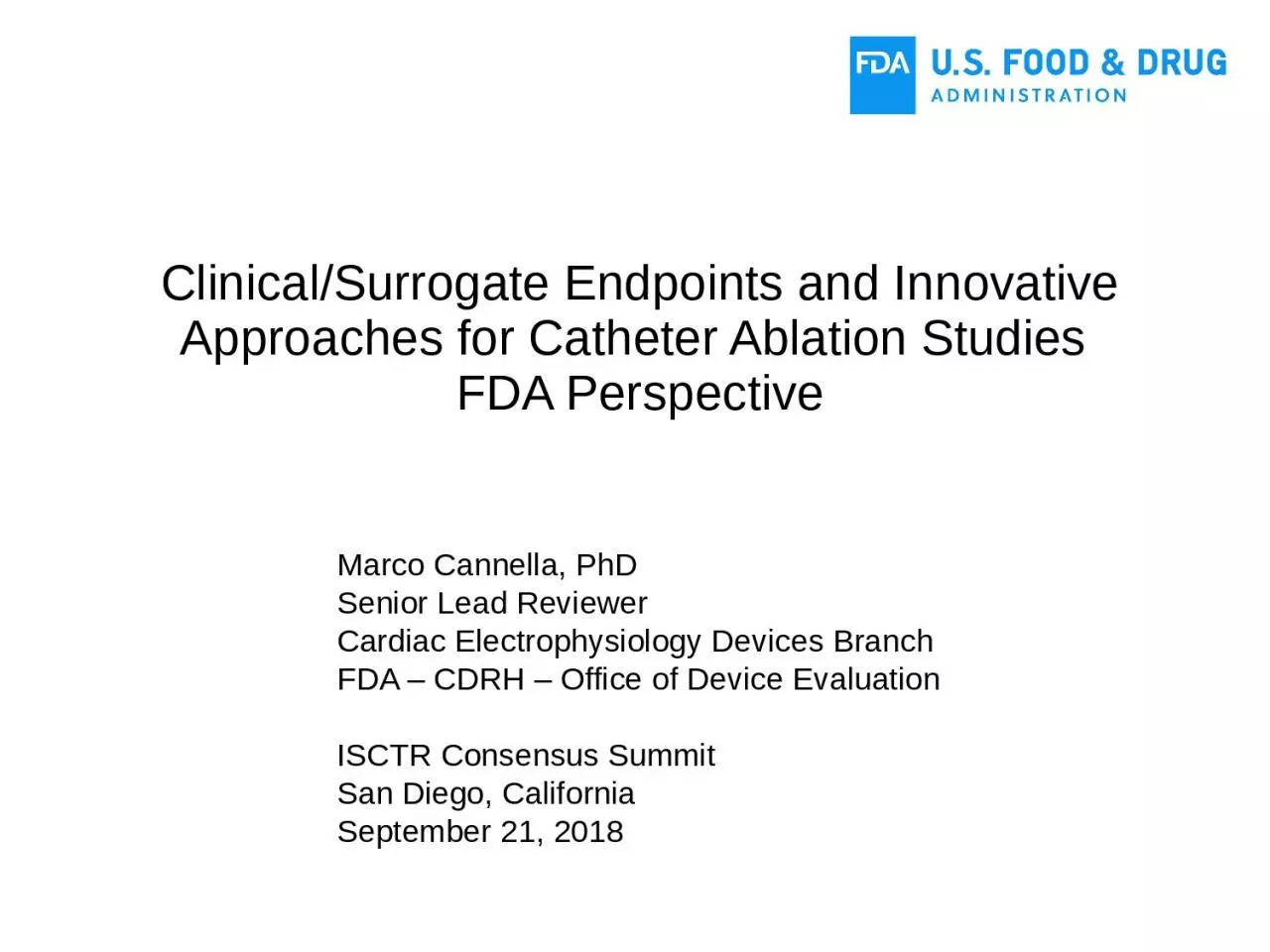

FDA Perspective Marco Cannella PhD Senior Lead Reviewer Cardiac Electrophysiology Devices Branch FDA CDRH Office of Device Evaluation ISCTR Consensus Summit San Diego California September 21 2018 ID: 932358
Download Presentation The PPT/PDF document "Clinical/Surrogate Endpoints and Innovat..." is the property of its rightful owner. Permission is granted to download and print the materials on this web site for personal, non-commercial use only, and to display it on your personal computer provided you do not modify the materials and that you retain all copyright notices contained in the materials. By downloading content from our website, you accept the terms of this agreement.
Slide1
Clinical/Surrogate Endpoints and Innovative Approaches for Catheter Ablation Studies FDA Perspective
Marco Cannella, PhD
Senior Lead Reviewer
Cardiac Electrophysiology Devices Branch
FDA – CDRH – Office of Device Evaluation
ISCTR Consensus Summit
San Diego, California
September 21, 2018
Slide2www.fda.gov
No Disclosures
Slide3www.fda.govProtects the public health
Advances the public health by helping
to speed innovations
, and by helping the public
get accurate, science-based information to use medical productsWorks with other groups supporting patients
FDA’s Role
Patients
ODE evaluates
medical devices for:
clinical trials
marketing
Slide4www.fda.gov
Endpoints or Answers?
Endpoints
are important for marketing studies
Answers
are needed to improve understanding!
Experience
Uncertainty
t
Traditional Feasibility
Early Feasibility
Confirmatory
Pivotal
New technology
Novel design
New indication
Small change
New feature
Answers
Endpoints
Device developments
Endpoints development
Test new approaches
Mechanism of action
Slide5Designing Study EndpointsEndpoints characterize the clinical effect of the device (for both safety and effectiveness) for the desired intended use.
www.fda.gov
Important factors to consider when developing endpoints:
Indication for use:
Population (drug refractory,
etc
…)
Arrhythmia (AFL, AF, VT,
etc
… )
Device design (focal, balloon
, etc…)
Device operational principle (RF,
Cryo
,
etc
…)
Scientific considerations:
Prior clinical experience (feasibility studies)
Current consensus *
*2017 HRS/EHRA/ECAS/APHRS/SOLAECE expert consensus statement on catheter and surgical ablation of atrial fibrillation (Calkins H. et al., Heart Rhythm, Vol 14, No 10, Oct 2017)
Slide6www.fda.gov
Endpoints for Ablation Studies
SAFETY
Endpoint:
For ablation devices it is typically a
30-day complication rate.Composite safety endpoint is developed to capture device procedure related complications.EFFECTIVENESS Endpoint:
For Atrial Flutter (AFL) an accepted surrogate is achievement of bidirectional block (acute effectiveness)*
For Atrial Fibrillation (AF) indication it is typically 12-month follow-up
For Ventricular Tachycardia (VT) indication it is typically evaluated within 6 to 12 months post procedure
*specifically for conventional RF ablation catheters. FDA is open to expand the use of this surrogate to other technology (
Cryo, Laser, etc
…) with valid scientific evidence (clinical trial, RWE, registry,
etc
…).
Slide7www.fda.gov
Endpoints (answers) for Feasibility Studies
The “answers” provided by feasibility and investigator studies can be used to shape the pivotal study endpoints or understand the best use of approved devices
EFS Studies (example: MR guided ablation)
Is the device design optimized for clinical use?
Are there potential advantages over conventional therapies?Feasibility Studies (examples: force sensing derived indexes, novel mapping diagnostic features)What is the clinical utility of these indexes?How can the mapping algorithm be validated?
What parameter may improve the therapeutic outcome?
Slide8www.fda.govEncourage innovation to answer clinical questions with EFS, Feasibility, and Investigator studies
Interactive reviews to facilitate the efficient and timely review and evaluation of IDE submissions
Least burdensome approach for new clinical studies:
novel study designs (Bayesian stats, modeling)
support use of Real World Evidence (RWE)
use of registries to support device small changesFDA Support of Clinical Study
Let’s step back and find the answer to the questions (arrhythmias mechanism, validity of proposed surrogate, etc
…) that will help us shape the endpoints for the future.
Slide9www.fda.gov
DCD Director: Bram Zuckerman
bram.zuckerman@fda.hhs.gov
CEDB - Ablation, Mapping, Imaging
Mark Fellman
301-796-6357
mark.fellman@fda.hhs.gov
IEDB - Pacing, ICDs, CRT, Leads
Jessica Paulsen
301-796-6883
jessica.paulsen@fda.hhs.gov
CDDB - Monitors, ECGs, Diagnostics, AEDs
THANK YOU
Marco Cannella
301-796-1657
marco.cannella@fda.hhs.gov
Slide10